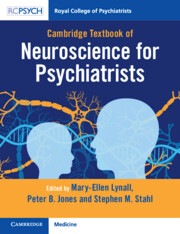Book contents
- Cambridge Textbook Of Neuroscience for Psychiatrists
- Reviews
- Cambridge Textbook of Neuroscience for Psychiatrists
- Copyright page
- Contents
- Contributors
- Introduction
- 1 Cells
- 1.1 Neurons
- 1.2 The Physiology of Neurons, Synapses and Receptors
- 1.3 Modelling Single Neurons and Their Combinations in Circuits
- 1.4 Glia
- 2 Neurotransmitters and Receptors
- 3 Basic Techniques in Neuroscience
- 4 Neuroanatomy
- 5 Neural Circuits
- 6 Modulators
- 7 Genetics
- 8 Neurodevelopment and Neuroplasticity
- 9 Integrated Neurobiology of Specific Syndromes and Treatments
- 10 Neurodegeneration
- Index
1.1 - Neurons
from 1 - Cells
Published online by Cambridge University Press: 08 November 2023
- Cambridge Textbook Of Neuroscience for Psychiatrists
- Reviews
- Cambridge Textbook of Neuroscience for Psychiatrists
- Copyright page
- Contents
- Contributors
- Introduction
- 1 Cells
- 1.1 Neurons
- 1.2 The Physiology of Neurons, Synapses and Receptors
- 1.3 Modelling Single Neurons and Their Combinations in Circuits
- 1.4 Glia
- 2 Neurotransmitters and Receptors
- 3 Basic Techniques in Neuroscience
- 4 Neuroanatomy
- 5 Neural Circuits
- 6 Modulators
- 7 Genetics
- 8 Neurodevelopment and Neuroplasticity
- 9 Integrated Neurobiology of Specific Syndromes and Treatments
- 10 Neurodegeneration
- Index
Summary
Cells are the fundamental units of tissues in multicellular organisms. Animal cells are sealed sacs constructed of extremely thin (≈5 nm) lipid bilayer plasma membranes, spanning across which are various membrane proteins. Crucially, the membrane separates an intracellular biochemical compartment, the cytoplasm, from the extracellular environment. This separation enables gradients, or differences in concentration, of ions and small molecules to be maintained across the membrane, and acts to contain the cytoplasmic proteins and enzymes involved in metabolism, as well as organelles, or intracellular membrane compartments. Particularly importantly for the nervous system, the membrane is also an excellent electrical insulator: it is energetically very unfavourable for charged entities like free ions and electrons to jettison their interactions with polar water molecules in order to cross through the uncharged, non-polar hydrocarbon interior of the lipid bilayer membrane, and so transporting them across the membrane is normally very difficult. This high resistance allows an electrical potential difference to be maintained across the membrane – the membrane potential. An electrical potential difference is equivalent to a difference in the ‘concentration’ of unbalanced charges between the two sides of the membrane.
- Type
- Chapter
- Information
- Publisher: Cambridge University PressPrint publication year: 2023

